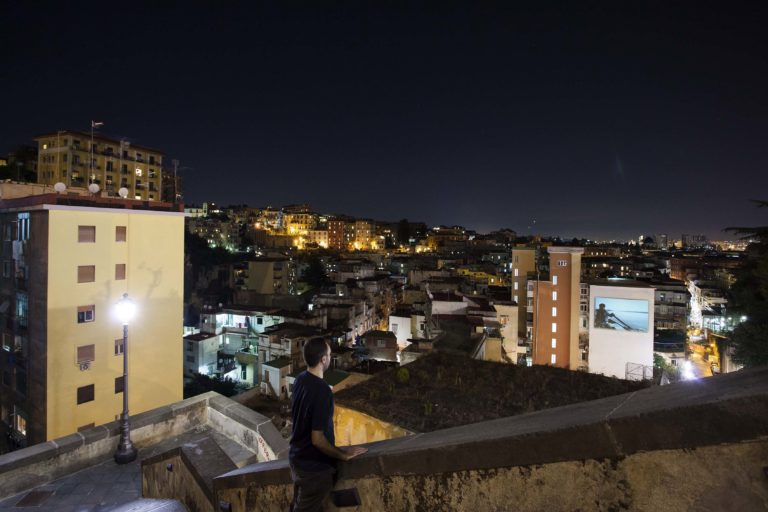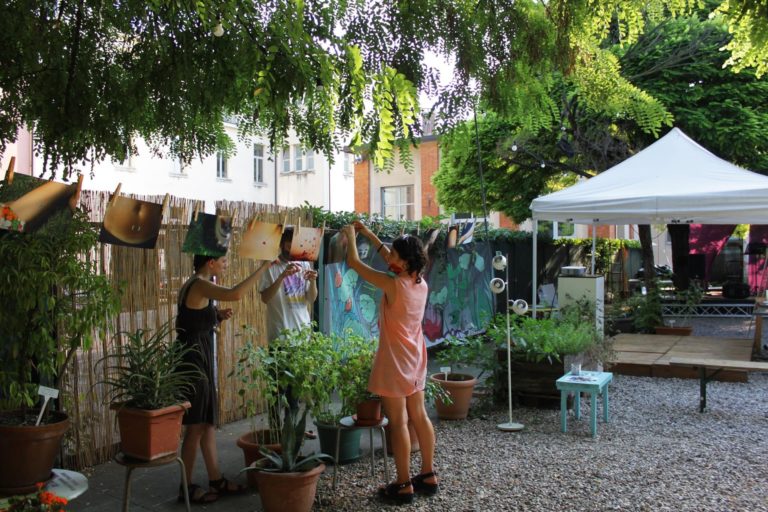Part. 1 of the series: Independent Cultural Spaces in Italy
Author: Matilde Bignotti
In recent years, Italy has seen the rise of independent cultural spaces that are reshaping local communities and cultural landscapes. These non-profit, grassroots spaces foster creativity, social inclusion, and urban regeneration, while resisting traditional institutional frameworks. In the first of a three-part series, Matilde Bignotti explores the hybrid identity of these spaces, highlighting their dynamic, community-driven approaches to culture. From revitalising abandoned buildings to hosting inclusive events, these spaces demonstrate the power of cultural independence in driving social change across Italy.

Quartiere Intelligente's Public Art Project in Naples – © Archive of Quartiere Intelligente
In recent decades, Italy has witnessed the rise of heterogeneous, non-profit, non-institutionalised spaces that bring innovation, community building, and economic development through culture, and thanks to independence. These spaces have become a phenomenon that crosses the country, from north to south, from historic centres to urban peripheries, acting as dynamic centres of transformation that extend beyond their borders by involving the local community, stimulating cultural production and consumption, and stimulating networks of collaboration. Beyond their approach and impact, they have little in common, as they do not conform to standardised development, location, or programming. Their spontaneous and heterogeneous nature is reflected in the variety of names used to identify them, each highlighting a key feature. Rather than being a limitation, this diversity offers a richer picture of these places and is a resourceful way of revealing the characteristics of such a virtuous example.
A New Way of Manifesting Culture
The first label used, New Cultural Centres, suggests the historical roots of the phenomenon and emphasises the central role of culture. According to an article in CheFare[1], these new cultural centres are the heirs of social centres: subcultural organisations that emerged in the late 1980s, found a place in squatted buildings, and engaged in political activism through cultural programmes. The ‘new’ centres appeared in the early 2000s, out of a mix of grassroots initiatives, public administrations, networks of non-profit actors, private sponsors, and urban regeneration plans. Such contact with public institutions makes it possible to borrow disused buildings for use or rent them at affordable rates, but it can also influence the political actions of these new centres. An example comes from a cultural centre in Vicenza, Porto Burci. Silvia, the project’s coordinator explains: “Since the city council turned ‘right’, there has been more control over our programmes, but also a lack of dialogue. For example, we organised a workshop to raise awareness around gender issues where the activities were named after categories of porn to provoke a critical reflection on sexual education. After seeing these names on the event poster, a counsellor asked us to cancel the workshop, refusing to hear our explanation.” Since this episode, they had to be more mindful about the tone of their communication. However, Silvia reassures: “the cultural programme itself remains a means of social and political transformation.” From interactive workshops to craft courses, book launches, seminars, live concerts, and parties, the choices made for the programme manifests the inclusive, progressive, and accessible approach of these new cultural centres.

Porto Burci in Vicenza – © Archive of Porto Burci, Arci Servizio Civile, and SpazioPorto
Community-Based Spaces
The heterogeneity of the programme is also a consequence of strong community ties. As Silvia describes: “We want to be a container for the initiatives coming from the city, not a mere creator of content. Anybody who has an idea or is willing to lead a workshop is more than welcome to get involved.” Freed from the dynamics of profit, cultural activities are often proposed by locals or shaped in response to local needs and demands. Local bands, emerging artists, creative collectives can find a space to perform, share, and experiment. Inclusivity doesn’t only apply to the arts and culture: “In the garden of our centre, Quartiere Intelligente, we also hosted weddings of LGBTQ+ couples.” said Adriana, founder and coordinator of this cultural centre in Naples. Not by chance another label used to refer to these spaces is: Community Hubs.
These hubs involve the community and the local territory not only through programmes, but also by partnering with third sector initiatives, public institutions, and informal artists’ collectives. “As part of the National Association of Community Service (ARCI Servizio Civile), we host and train young volunteers coming from all over the country. By including them in social projects focused on our territory, they learn and nurture active citizenship,” said Nora, founder of Porto Burci. On this topic, Adriana talks about the art projects of Quartiere Intelligente: “We hosted parties and debates about the future of electronic music proposed from SMARGIASS, an informal collective from the city. Whereas our public art initiatives have always been done in partnership with Naples’ Museum of Contemporary Art.”
These places also have a strong micro-level impact, stimulating intercultural and intergenerational dialogue. Indeed, with inclusion as a core value and the suburbs as a location, these spaces are able to reach out to communities that are sometimes left behind by public institutions. “The location of Centro Tecchio was really appealing to us,” said Nora, introducing the new, extended location of Porto Burci, “as it is located in a suburban and intercultural neighbourhood of Vicenza, which allows us to reach out to foreigners with free language courses, information points and social activities.” Similarly, Nuovo Armenia, a space in the Dergano district of Milan, reflects and promotes the multicultural composition of its community by showing films from participants’ home countries and encouraging dialogue and presentations.
Collective Efforts for Urban Regeneration
The community-based, bottom-up approach of these spaces stems from their origins. Often referred to as Collective Spaces, these initiatives are the result of informal, diverse, and proactive groups who aim to enrich the local, social, and cultural scene by creating open, dynamic spaces. The benefits of participatory culture and social services extend far beyond the boundaries of the space. Indeed, their impact has been recognised by city councils as well and cultural centres became part of broader urban regeneration strategies. It is the case in Milan, where the collective space Mare Urbano was included in a plan to renovate social housing in order to bring new opportunities to a suburban area where the diverse population lacked cultural opportunities. Another example is Puglia, where several municipalities, in partnership with the region, invested €64 million in a project to recover and reuse a range of public spaces, from slaughterhouses to former monasteries, transforming them into organisations with cultural, artistic, recreational, and socio-educational facilities.[2]

Language courses in Porto Burci – © Archive of Porto Burci, Arci Servizio Civile, and SpazioPorto
Hybrid and Independent Spaces Above All
The profile that emerges from the multiple labels explored so far is as vivid, in its intentions and actions, as it is hybrid in its form. These seemingly various and unstandardised characteristics have recently been brought together under a single name; Hybrid Spaces, which captures their heterogeneous programmes and their flexible, multifunctional, and community-driven nature.
Such fluid identity represents their strength and uniqueness as well as a challenge for their governance and legal definition. Torino Creativa[3], a publication that aims to fill the information gap around the topic of cultural regeneration, highlights how cultural centres are deeply intertwined in different fields: arts, social work, and entrepreneurship. However, they are not exclusively neither, and “for this reason the challenge of policies is to be able to design flexible and at the same time suitable instruments to support each individual route.” Autonomy from private and public institutions, coupled with strong community ties, is crucial for hybrid spaces to allow artistic experimentation and social services. At the same time, pursuing an entrepreneurial direction would turn a hybrid space into a profitable start-up, which would benefit its security and long-term planning. This choice, though, would backfire in terms of diversity of cultural programming and social engagement as the centre would be dependent on the standards and requirements of the cultural market.
The last and most common label used, Independent Cultural Centre, suggests which direction these spaces decided to prioritise. As studies confirm, most independent cultural centres choose a legal form that preserves this core need: the non-profit cultural association. The association form gives these spaces legal recognition to collaborate and partner with public and private institutions, to obtain permits and to apply for public tenders and funding from foundations. However, there are limitations: the public funds allocated from the Italian State to associations can only cover 30% of the projects’ costs and are usually short-term investments, which calls into question the financial sustainability and the possibility of long-term planning. “Especially when talking about large amounts it is unsustainable for us to cover the 70% of the costs. Sometimes you win the call, but then you realise by doing more specific accounts that you can't get the project off the ground,” admits Adriana from Quartiere Intelligente. The compensation of the staff is also an issue for independent cultural centres. Many spaces, as Quartiere Intelligente, direct the revenue gained from their bar and bistro to pay the staff. But, as the data collected from Torino Creativa shows, the income that comes from self-financing activities, private sponsors, and membership fees is barely enough to maintain and rent the premises. Eventually, the main source of staff for the independent cultural centres is the volunteers.
All these labels shed light on a peculiar space where the public, private, and local spheres intertwine and generate social change. Such impact is the result of the hybrid and non-profit nature of cultural centres, whose inclusive and creative approach make them “hubs of generative welfare,[4]” to use the words of Roberta Franceschinelli, the president of the cultural foundation Labsus.
Nonetheless the recognition that cultural centres are gaining, their grassroot and heterogenous identity makes it challenging for public institutions to recognise them and design appropriate policies and norms. As they belong to the third, non-profit sector, the actions of cultural centres are still ignored by the statistics that measure the impact of culture on the local economy, which cuts them out of the picture of public welfare policies. This information gap has been fulfilled by independent research and networks, but, as it will be explored in the next article of this series, it is necessary to switch perspectives on welfare, cultural regeneration and economy of culture for hybrid spaces to be understood and supported in their full potential.
[1] Bertram Niessen, “Cosa sono i nuovi centri culturali, l’avanguardia della trasformazione culturale,” CheFare, October 17th, 2019
[2] Marco Ranieri, “Riuso e valorizzazione degli spazi pubblici urbani in Puglia: un breve excursus storico,” DiTe, July 18th, 2024
[3] Enrico Bertacchini and Giangavino Pazzola, “Torino creativa. I centri indipendenti di produzione culturale sul territorio torinese,” Ass. per il Circuito dei Giovani Artisti Italiani, March 2015
[4] Elena Taverna, “I nuovi centri culturali sono presidi di Welfare generative,” Labsus, May 24th, 2020
Published on October 1st, 2024
About the author:
Matilde Bignotti is an Italian freelance event curator, writer, and coordinator of community-based projects. In the Netherlands, Matilde has collaborated with institutions such as Centraal Museum, Utrecht University and DeVoorkamer in writing and facilitating programs that generate inclusivity through creativity and co-curation.